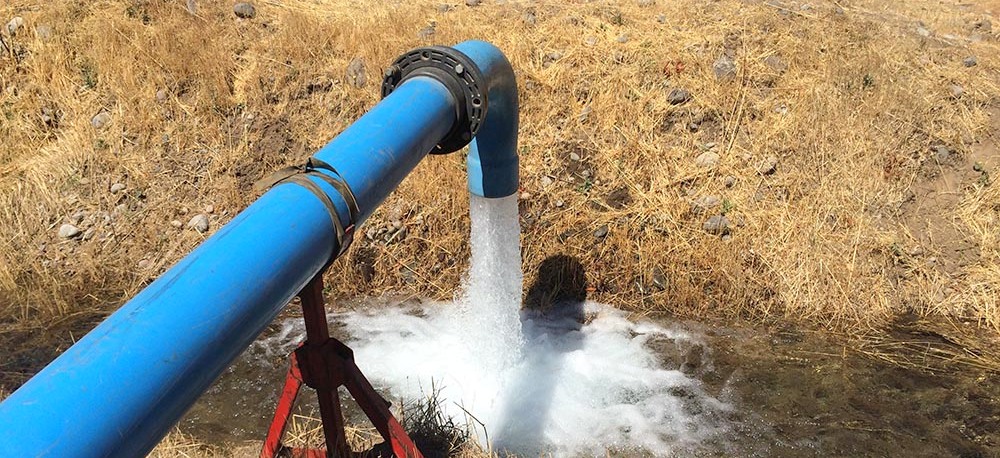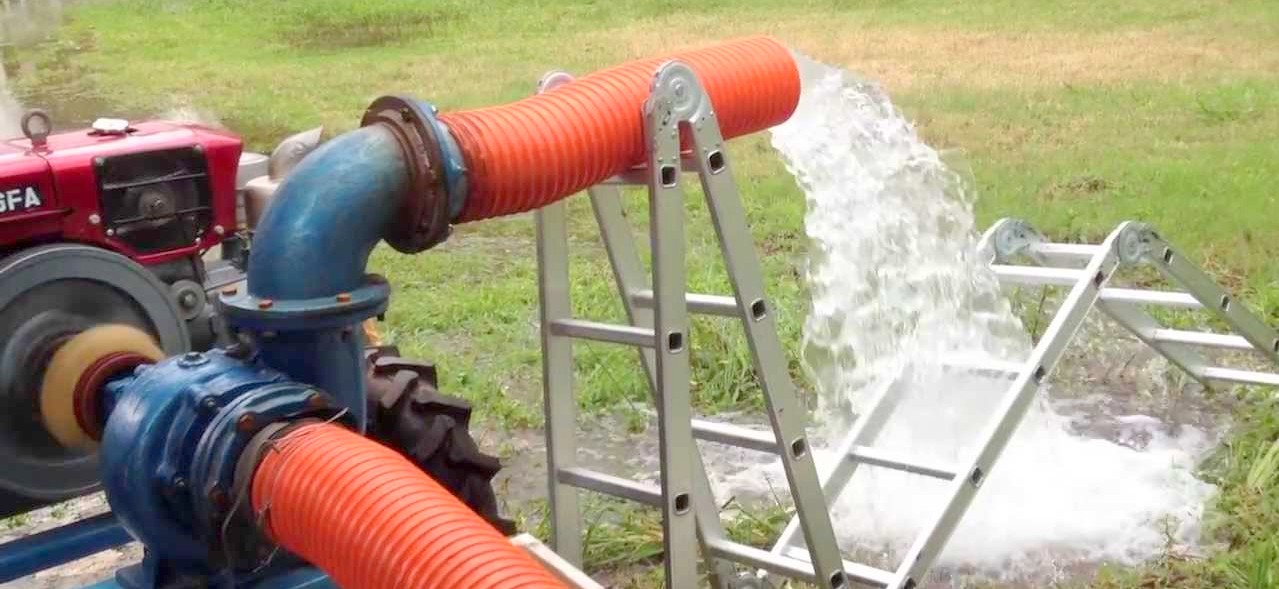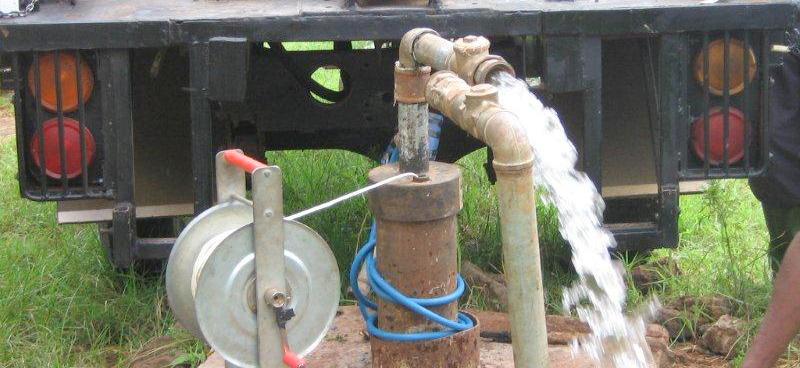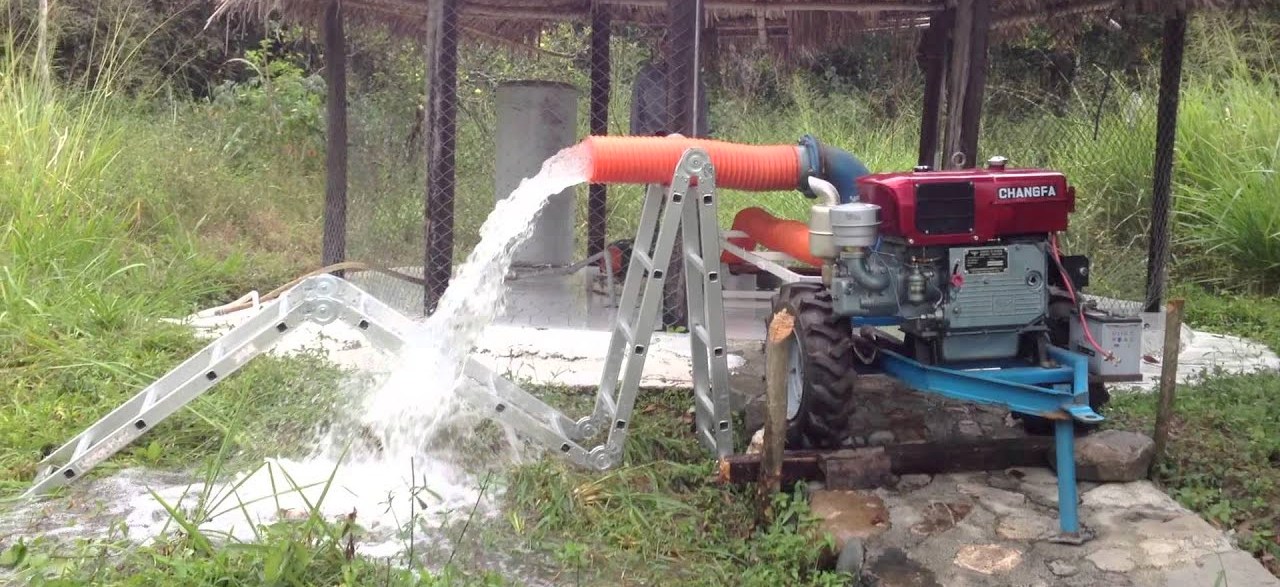



Test Pumping
Upon satisfactory construction of a borehole, we shall use an electric submersible pump with fully functioning non-return valve in the pump itself. We shall then proceed with expeditious test pumping operations. This will have been specified and designed to test aquifer parameters such as hydraulic conductivities, transmissibility and storability from which design yield will be determined.
The assessment of water well yields is carried out by pumping water from the well at a controlled rate while the effects of this water extraction on water levels are monitored by measuring the difference of the levels before pumping starts (static water level) and during pumping (dynamic water level) at the well itself or at observation wells. Yield and drawdown data can be used to determine the well’s specific capacity (discharge-drawdown ratio of the well), which is a parameter to take into consideration when determining possible costs for pumping and for the selection of the most adequate pumping equipment; the specific capacity gives a measure of the effectiveness or productive capacity of the well. Pumping tests are also performed to determine the hydraulic characteristics of the aquifers (aquifer tests), necessary to assess the total and long-term productivity of a series of wells tapping an aquifer. These characteristics are defined by several groups of hydrogeological parameters. An important one defines volumes of water that may be released or stored by the aquifer (storage coefficient or specific yield); another group defines flow rates that may be obtained from the aquifer (transmissibility and hydraulic diffusivity). Three main types of pumping tests are generally performed:
i) Constant yield tests with no observation wells. In these tests, water levels are periodically measured at the well itself while water extraction is carried out at a constant pumping rate. After pumping is stopped, water levels (recovery water levels) are periodically controlled until the original water table level is reached again at the well. Rough estimates of the well’s specific capacity and of the aquifer’s transmissibility may be obtained through the analysis of this type of test.
ii) Constant yield tests with observation wells. As in the case above, pumping and recovery levels are measured. Measurements are performed at one or more observation wells whose relative location in respect’ of the pumping well and the aquifer should be known as accurately as possible. These tests are usually performed as aquifer tests to obtain, from their analysis, very accurate estimates of the aquifer’s transmissibility, its specific yield or storage coefficient as well as estimates of possible interference between adjacent production wells.
iii) Variable discharge tests or step-draw down tests are performed by pumping the well during successive periods, usually of one hour duration, at constant fractions of its full capacity. During the test, water levels in the production well are measured at frequent intervals. Specific capacity determinations are more accurately obtained through these tests which, if properly analyzed, also provide very good estimates of the well’s efficiency as a water intake structure. In simple terms, these tests provide an idea of how construction and design characteristics affect the well’s capacity to produce water and may be used to assess techniques and design.
As step-draw down tests usually consist of four steps, they may be performed in less than 6 hours. Constant yield tests require a much longer time. Only with time will draw down measurements reflect accurately the real conditions of the aquifer; at the beginning of the test draw downs increase at very fast rates, but as pumping continues the well draws water from larger portions of the aquifer and the dynamic water level deepens at a decreasing rate with time. Stabilized conditions at the well (when the well draws water at the same rate it is being recharged to the aquifer) are obtained at the moment the water level at the well does not show any additional drawdown. Experience shows that this happens after between 15 to 36 hours of pumping. The recommended duration of this type of pumping test is, therefore 48 hours. When, for practical reasons, the duration of the tests should be lowered, the decision should take into account that economizing on the period of pumping is not justified because the costs of running the pump a few extra hours is low compared with the total costs of the well and of the test itself; the operation and maintenance of the well and of its pumping equipment will benefit from a correct choice of specifications and from the knowledge of the aquifer and the well gained by the test. Water level measurements (at pumping or observation wells) are taken many times during the course of a pumping test, and as accurately as possible. Since water levels drop fast during the first two hours of a test, readings should be taken at brief intervals, with the time between readings being gradually increased as pumping continues.
After the pump is shut down, water levels in the pumped well and in the observation wells will start to rise. In the first hour they will rise rapidly, but as time goes on the rate of rise decreases. These recovery levels are also measured, and the analysis of recovery data usually allows more reliable calculations of aquifer parameters. Rates of pump discharge during a pumping test should be controlled in order to keep them constant and to avoid complicated calculations during analysis. Flow rate measurements should be accurate and recorded periodically, at least once every hour, and necessary adjustments must be made from time to time to keep the discharge rate constant; this can be done with a gate valve in the discharge pipe which is more accurate than by changing the speed of the pump. If an appropriate water meter is not available, flow may be measured with a bucket (the most simple method which, if carefully performed, may render quite accurate results), with an “orifice weir” or any other method explained in relevant literature.
